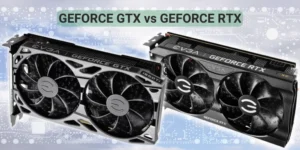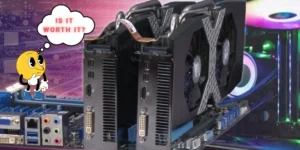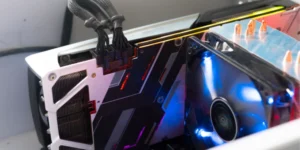You are a computer enthusiast. You’re ecstatic to build your first PC. After a long period of research and self-effort, your computer is finally done. You turn it on and get to work.
The power indicator light is on, and the RGB fans in the PC case are gleaming. But then you notice that the GPU fan isn’t spinning.
What happened to it? Are there any mistakes or errors in the PC building process?
GPU fan not spinning is a common issue with PCs. In short, GPU (Graphics Processing Unit) is a processing unit that handles graphical tasks like graphic rendering, machine learning and editing. While operating, the GPU generates a lot of heat. It has cooler heatsink with a fan attached on top to dissipate heat and keep the GPU running normally.
The fan may stop spinning and lose its capacity to perform efficiently due to some technical difficulties. These kinds of events can be really aggravating.
It’s understandably upsetting to discover that your GPU fan isn’t functioning properly. However, as long as there is a problem, there will be a solution. There are a number of factors that can cause GPU fans to stop spinning:
- GPU is in idle mode: This is the normal operating mode of the most graphics cards. The GPU fan only turns on when the GPU reaches a certain temperature.
- Power supply: It is possible that the power supply to the GPU is insufficient for a variety of reasons, including a loose connector or a damaged power cable.
- GPU fans are not properly maintained: excessively dirty, dry bearing oil.
- Failed components: Perhaps the fan is damaged, or, in the worst-case scenario, the motherboard is no longer functional.
Even if your PC has been working properly for a long time, then the fan suddenly stops spinning, the problem can be easily diagnosed and fixed. Let’s go over the specifics together below.

What Is GPU Fan?
When operating, GPU, like CPU, generates a lot of heat, particularly when performing heavy workloads. As a result, a cooling system is required to keep the temperature within a safe range. Typically, the GPU cooler is made up of two major components:
- Heatsink mounted on top of GPU: it has the most exposed surface area to maximize heat dissipation.
- The fan attached to headsink is known as the GPU fan, and it helps to adjust airflow in this particular processor.
RELATED: How Hot Is Too Hot for GPU? A Guide To Graphics Card Temperature
GPU Fan Not Spinning: Potential Causes
GPU fans that do not spin can be caused by a variety of factors, including incorrect driver configuration, excessively dusty fan blades, and stuck bearings caused by oil drying. In some cases, the fan will not spin because the GPU’s temperature remains within a safe range.
What we need to pay attention to is where the causes come from and how to deal with them. Let’s take a closer look at the following reasons.
GPU Is In Idle Mode
Some graphics cards won’t spin until a certain temperature is reached. They have a passive cooling mode that is intended to help them reduce system noise. In this case, many people finish building their PC, use it for a while, and then notice that their GPU fan is not spinning. When they eventually see it isn’t rotating, they assume something is amiss when, in fact, it is exactly how the card was supposed to work.
Many graphic cards now have this feature built in to reduce noise. As a result, users must run their PC for a period of time before the GPU fan begins to spin.
For example, if you’re watching a YouTube video or simply staring at your screens and wondering why the fan isn’t spinning, it’s because you’re not putting any strain on the card. When the GPU is under heavy load, the fan will spin to dissipate heat for the GPU.
Some GPUs only start spinning when the card reaches a certain temperature (usually 60 degrees). This temperature threshold is called Idle Temperature.
If you find that the GPU fans is not spinning while in idle temperature mode, then this is not unusual in this case.
If your GPU is under heavy load, such as gaming or 3D animation rendering, and the GPU fans are still not spinning, it could be one of the issues discussed below.
Power Isn’t Connected
It’s possible that when connecting the power cables for the graphics cards, the connectors aren’t properly plugged in. As a result, after some time, the power to the graphics cards is insufficient, causing the GPU fans to stop spinning.
Some inexperienced builders fail to remember to plug things in. People have created a lot of systems and always neglected to connect stuff in. It happens all the time. So, one of the reason your GPU fan isn’t spinning could be that you made a mistake with your power connector.
Too Much Dust On The GPU
If your PC has been used for a while without proper maintenance, dust can accumulate on the fan blades, making it difficult to function properly. If you open the PC case and see a lot of dust, it’s time to clean your graphics cards and other components.
After you’ve finished cleaning, if the GPU fan spins normally, you’re done. If this is not the case, there could be a few other reasons.
Is It Necessary To Oil The GPU’s Fan Bearings
Friction surfaces must always be lubricated. In this case, it is the fan bearings. They must be oiled and maintained on a regular basis in order to run smoothly and last a long time.
If oiling the fan bearings does not improve the situation, the cause may be that the fan is damaged and needs to be replaced.
How To Fix GPU Fan Not Spinning?
Check If GPU Is In Idle Temperature
Even though the GPU fans have a modest torque, they nonetheless produce noise, which contributes to noise pollution. Not only does turning off the fan lessen noise pollution, but it also reduces the risk of overheating other elements of your PC as well as increase the lifespan of the PGU fans.
Checking to see if the GPU is in idle mode is a critical step. You could have serious problems if you don’t notice that the fan isn’t spinning due to a problem. This may cause GPU overheating.
Installing the MSI Afterburner software is a good solution. As a result, you can check the GPU’s temperature, adjust the fan curve, and even manually adjust the GPU fan’s speed. If you try to use this software to force the GPU fans to spin but it doesn’t work, it’s possible that your PC or GPU is having some problems.
Cleaning Dusty Fan
Of course, after a long period of operation, the blade of your GPU fan can accumulate a lot of dust. Do you usually disregard the inside of a PC case? It’s time to open it and look inside. You might be surprised at how filthy it turned out to be. Dust on the fans can prevent it from spinning.
Of course, after a long period of operation, the blade of your GPU fan can accumulate a lot of dust. Do you usually disregard the inside of a PC case? It’s time to open the case and look inside. You might be surprised at how filthy it turned out to be. Dust on the fan can prevent it from spinning.
Remember to remove the graphics cards from the your PC and clean them in a well-ventilated area.
You can clean your GPU fan with an air blower or a hair dryer. Keep it at the lowest setting and eight inches (200mm) away from the fan. This method is also useful for cleaning dust from CPU’s heatsinks and fans.
RELATED: Causes of High CPU Temperatures And Fixing Measures
Oiling The Bearing Of GPU Fans
Have your GPU fans been running for a long time without being serviced? Periodic oiling of fan bearings, like that of other mechanical devices, is essential. This procedure is applicable not only to GPU fans, but also to CPU cooling system and PC case fans.
Steps for implementation:
- You must remove the graphics cards from your computer.
- Remove the sticker from the fan.
- Drop specialized oils, such as WD-40, into the bearings. Manually rotate the fan to ensure that the oil is evenly distributed in the bearing.
- Close the sticker and then reconnect the graphics cards to the PC to make it work again.
Restart your computer
The best solution to solve the problem of a stagnant GPU fan is to restart the computer system. It is ostensibly the most basic of all the ways or solutions. Even IT engineers all over the world prefer to restart their computers, which helps to reboot the system, align the specific functionality, and restart the GPU fans’ spin. We must double-check the power supply and the PCI-E slot on the corresponding motherboard to ensure that they are both connected.
Checking PCIe Power Connectors
Graphics cards these days demand more power to run simply because they are more powerful. As a result, existing PCIe slots are unable to provide sufficient capacity on their own and require an additional power supply.
High-end graphics cards usually have separate PCIe power cables that connect directly from the Power Supply Unit (PSU). There is one end that plugs into the PSU and the other end to the connector on the graphics cards. There are two types of PCIe power connectors: 6-pin and 8-pin. One of them, or a mixture of both, is normally seen on the side of the card.
RELATED: Where Does PCIe Cables Go – A Guide To Powering Graphics Cards?

Since the power cables may not be connected properly or loose, the GPU receives less power than it requires, and as a result, your GPU fans may not rotate due to a lack of power.
The wires themselves could be damaged or broken, so experiment with various cords to see whether they spin. Make sure the power connectors aren’t loose or touchy, and that the pins are securely fastened.
Most people, especially beginners or first-time builders, fail to connect the power cables to the PSU or even to link them into the GPU; make sure the wires are properly plugged into the power connections and the PSU.
It should be noted that some graphics cards operate solely on the power provided by the PCIe slot and thus do not have the additional power connector. If you’re using one of those devices and your fan isn’t spinning, you can remove the card, clean its pins, and reinstall it.
Use A Different Computer To Test Your GPU
If your GPU fans are still not working after attempting the majority of the workarounds, you can test their rotation on another computer. Check that the computer used for this test is still in good working order.
When testing on another computer, the GPU fans continue to function normally, your PC may have a problem. This issue should be taken to a computer repair shop. They have the necessary experience and tools to diagnose and fix your PC.
Replace The GPU/Fan
If testing on another computer still fails, you may consider replacing the GPU fan with another. Before ordering a replacement fan, double-check the manufacturer’s specifications.
In case you can just replace the fan, you won’t have to spend hundreds of dollars on a new GPU to finish your work. Simply swap out the fans and you’re ready to go. However, replacing the fan may not always be a simple task. If your graphics cards have been used for a long time, then replacing or upgrading the graphics cards is an option worth considering.
Fortunately, there are many excellent options available right now. If you decide to upgrade your GPU, you can look up benchmarks and other relevant information on the internet. With your upgraded graphics cards, you can have amazing new experiences.
Conclusion
Are you a gamer or a graphics expert? Graphics cards with powerful GPU can help you satisfy your passion. Take care of it, and you will be rewarded.
When your GPU fan stops spinning, you must investigate the possible causes and resolve the problem as quickly as possible.
The solutions and methods listed above are widely used and have been proven to work. As a result, diagnose your problem and employ the solutions that best meet your requirements.





